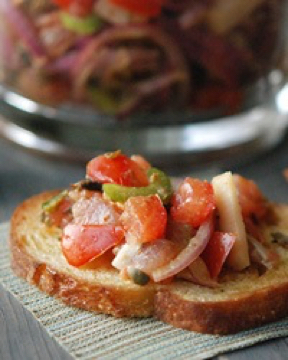- ¼ cup olive oil
- 2 ancho chiles, soaked in hot water for 25 minutes and drained
- 1 teaspoon finely grated lime zest
- Fresh mint and cilantro leaves, for garnish
- 2 tablespoons fish sauce
- 2 serrano chiles, seeded and coarsely chopped
- 2 tomatoes, cut into 1/2-inch dice
- 1 small red onion, quartered and thinly sliced
- 7 ounces hearts of palm, drained and thinly sliced crosswise (about 1 cup)
- 3 tablespoons salt-packed capers, rinsed, soaked in water for 1 hour, drained and coarsely chopped
- Baguette toasts or sticky rice, for serving
- 3 celery ribs, thinly sliced
- 1 tablespoon vegetable oil
- 2 tablespoons roasted rice powder, for garnish (optional; see Note)
- Salt
- 1 ½ tablespoons fresh lime juice
- 1 teaspoon sugar
- 2 lbs. center-cut sushi-grade tuna steaks, cut into 1/2-inch dice
Everyone is so obsessed with sushi that anytime the raw-fish subject comes up, everyone automatically assumes there is a Japanese connection to the recipe. Well, Mexico, Korea, Italy, Morocco and Vietnam (to name just a few countries) all have a vibrant raw-fish tradition, and some of my favorite dishes are Vietnamese fish salads.
I first tasted this dish on the island of Cat Hai, off the Vietnamese coast, a place well known to food geeks as the birthplace of nuoc mam, the world’s best fish sauce. In their salad, they used a small, pale, oily fish that is not available in this country, but the texture and the flavor reminded me of tuna, so when I adapted this recipe, I used the best and freshest tuna I could find. You can also make this dish with shrimp, salmon, crab, snapper, scallops or small mackerel when they are in season. I think that the Asian fish salad concept—combining chopped and sliced vegetables and fish with bold seasonings, like toasted rice powder, lime, fish sauce, chiles and the like—is one of the world’s truly great food genres, and it gives the cook a ton of leeway when it comes to playing with his food. But getting back on track, my crew and I were in Cat Hai, walking down the one road in town, right in the center of the island. It was hot and dusty and everyone was inside eating lunch at home, taking a break in the heat of a summer afternoon. We fell into a small restaurant that was really the front porch of a family home. They walked us out back to their "kitchen," pointed at a few raw ingredients and looked at me. I waved my arms in the international traveler’s code indicating "all of it," and my crew and I returned to our table to wait for lunch. Over the next hour, we had a superb sour fish soup, chicken in hot chiles with lemongrass, small fresh shrimp spring rolls, smaller fried pork and bean thread egg rolls, grilled fish and this salad. I have made it ever since.
The style of frying and mashing the dried chiles is very familiar to cooks from this part of Vietnam. But when developing my version of the recipe, I used Mexican ancho chiles, which work a lot better for American cooks. I also use capers in place of the small, salted, pickled vegetables that are not available in this country.
ingredients
directions
1. Remove the stem and seeds from the ancho chiles and pat dry. In a small skillet, heat the vegetable oil until shimmering. Add the anchos and fry over moderately high heat, turning once, until blistered and fragrant, about 2 minutes. Blot the anchos with paper towels and transfer them to a food processor. Let cool. |
2. Add the serrano chiles, fish sauce, lime zest and juice and sugar to the food processor and puree until smooth. With the machine on, drizzle in the olive oil. Season with salt and transfer to a large bowl. |
3. Add the tuna, onion, tomatoes, celery, hearts of palm and capers to the chile dressing and toss well to coat. Season with salt. Cover and refrigerate for at least 20 minutes. |
4. Transfer the salad to a serving dish. Sprinkle with the rice powder and garnish with mint and cilantro leaves. Serve chilled, with toasts or sticky rice. |
Notes
 Notes NotesRoasted rice powder, known as khao kua pon in Thailand, is popular in East Asian cooking for its toasty flavor and its binding effect. It’s available at Asian markets. Or, you can make it: In a small skillet, toast raw glutinous (sticky) rice over moderately high heat, stirring occasionally, until golden brown and fragrant, 3 to 4 minutes. Transfer the rice to a mortar or spice grinder and let cool completely. Grind the rice to a coarse powder. |
 Serve with baguette toasts or sticky rice. Serve with baguette toasts or sticky rice. |
